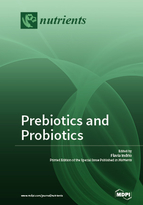Prebiotics and Probiotics
A special issue of Nutrients (ISSN 2072-6643).
Deadline for manuscript submissions: closed (30 September 2017) | Viewed by 415541
Special Issue Editor
Interests: pediatric gastroenterology with a special focus on probiotic and prebiotic
Special Issue Information
Dear Colleagues,
The purpose of this Special Issue, “Prebiotics and Probiotics”, is to focus on the importance of intestinal microbiota for human health and disease and the possibilities of influencing its composition and function with probiotics and prebiotics.
The goal of this Special Issue is to clarify that the microbiome in the maternal fetal and pediatric age unit, as well as the immediate changes that occur as new microbes are acquired postnatally play major roles in subsequent health and disease. Rapidly developing technologies for multi-omic analyses and systems biology are shifting paradigms in both scientific knowledge and clinical care.
Finally, the idea will be to provide health professionals with comprehensive, understandable and friendly readable update information on the intestinal microbiota, probiotics and prebiotics.
Dr. Flavia Indrio
Guest Editor
Manuscript Submission Information
Manuscripts should be submitted online at www.mdpi.com by registering and logging in to this website. Once you are registered, click here to go to the submission form. Manuscripts can be submitted until the deadline. All submissions that pass pre-check are peer-reviewed. Accepted papers will be published continuously in the journal (as soon as accepted) and will be listed together on the special issue website. Research articles, review articles as well as short communications are invited. For planned papers, a title and short abstract (about 100 words) can be sent to the Editorial Office for announcement on this website.
Submitted manuscripts should not have been published previously, nor be under consideration for publication elsewhere (except conference proceedings papers). All manuscripts are thoroughly refereed through a single-blind peer-review process. A guide for authors and other relevant information for submission of manuscripts is available on the Instructions for Authors page. Nutrients is an international peer-reviewed open access semimonthly journal published by MDPI.
Please visit the Instructions for Authors page before submitting a manuscript. The Article Processing Charge (APC) for publication in this open access journal is 2900 CHF (Swiss Francs). Submitted papers should be well formatted and use good English. Authors may use MDPI's English editing service prior to publication or during author revisions.
Keywords
- microbiota
- prebiotics
- probiotics
- health
- disease







